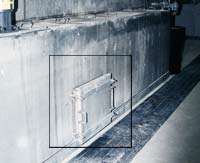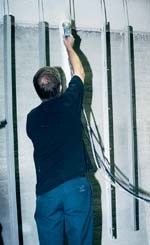Painting More Efficiently
To keep your customers happy, paint managers must produce high-quality parts. To keep the boss happy, paint managers must also do it efficiently...
The goal for every paint line manager is to produce parts with the highest quality finish while using a minimum of resources, whether those resources are people, energy, materials or time. In other words, the paint line manager is striving for maximum efficiency.
Of course, maximum efficiency will never be reached—there will always be some wasted material or energy lost. No system is perfect. But, even though maximum efficiency can't be reached, the paint line manager must do whatever he can to increase the painting system's efficiency. Even minor adjustments or changes can produce dramatic increases in efficiency, which lead to cost reductions and/or higher throughput.
Featured Content
Building a New Line
Dunbarton (Dothan, AL) is a manufacturer of building products (primarily steel door frames sold under the Rediframe and Bifold brand) for commercial properties, apartment complexes, condominiums, etc. Until recently, the company was using a painting system it had installed during the 1970s. While the line was still quite capable of producing high-quality parts, it was limiting the company's potential. "Basically, we needed a new line because our owner wanted us to grow the business and we had exceeded our capacity. We built an 18,000 ft2 extension, but it was filled up in a short period of time," stated Willie Holman, paint superintendent at Dunbarton.
It was Mr. Holman's desire to create the most efficient line possible and one that would be able to adjust to any future environmental regulations. To do this, Mr. Holman and Blake Seymour, mechanical engineer at Dunbarton, began gathering all the information they could about which coating would be best for the company's product and the most efficient method to apply that coating. "Blake and I did 3 years worth of research in about 6 months," said Mr. Holman. "We really didn't have any limitations on our costs at first. We knew that eventually we would. We wanted to go out and find the best system and determine how much of it we could use and how much of it was realistic."
Mr. Holman and Mr. Seymour began traveling to various paint equipment suppliers to see what each could offer. The two also visited a number of finishers to get their impressions about the various paint equipment suppliers and their equipment firsthand. After a lot of hard work, Mr. Holman and Mr. Seymour narrowed their search to two suppliers. "Each of them brought us a proposal. Our president met with each of them. We wanted to make sure that once we got going there wouldn't be any delays. Eventually, the decision was made that George Koch Sons would be our supplier. We were very pleased with what we saw at their installations. They looked like they were a top notch organization," explained Mr. Holman.
Paint System Efficiencies
Mr. Holman worked with the engineers at Koch to examine each aspect of the painting process and create the most efficient system possible.
Conveyor. The door frames that Dunbarton manufactures have to meet any color that an architect specifies. That means virtually every job that goes on the paint line is a custom one. In order to meet its customers' color requirements Mr. Holman may need to rack parts on the line that will be painted in three or four different colors due to the line's length and speed. Therefore, Mr. Holman asked Koch if it could design a conveyor that went forwards and backwards.
"One of the unique things that the engineers did that really took some innovation was the ability to reverse my line. We can physically back the conveyor up," stated Mr. Holman. "Even though our painters are professionals and they're good at what they do, the line moves fast enough that it's possible to miss frames. Also, when you do as many colors as we do and you're only doing 20 sets of something, you don't want to wait an hour-and-a-half for the line to go all the way around. If you know you made a mistake and you don't want to wait for it to go all the way around and the part to come back and fix it, then we'll stop the line and back it up so the painter can start over again. It gives us the ability to do it right the first time instead of having to wait for the part to come all the way around. It doesn't happen often, but it does from time to time."
Not only was the conveyor built to accommodate Dunbarton's custom color requirements, but it also takes into account the company's desire to have a finishing system that can adjust to future environmental regulations. How so? Well, Mr. Holman wanted to leave the option open for the company to switch to powder coating at any time. "All we need to do to convert to powder is install the powder booths," boasted Mr. Holman. Therefore, the conveyor was constructed to allow the use of a roll-on/roll-off powder booth. Also, extra length was added to the line (even though it wasn't needed for high-solids painting) to provide time for part cool down between the dry-off oven and the potential powder coating booth. (For more on Dunbarton's decision to use a high-solids coating instead of a powder coating, go to the Find Out More in this article.)
Ovens. Both the dry-off oven and curing oven on Dunbarton's painting line have several special features that make them more efficient. The interior walls of the ovens have a smooth surface. This means downdrafting can be used to assure a cleaner atmosphere by directing dirt particles towards the floor-mounted recirculation duct. This helps keep the parts from being recontaminated after they've been cleaned. The concrete floor is insulated, which reduces heat loss and gas consumption. The cure oven also reduce heat loss with an air barrier heat seal. The air seal reduces heat loss through the openings by recirculating the oven air through high-velocity nozzles. The adjustable nozzle angle optimizes heat sealing capabilities.
The dry-off oven also has one other unique feature. To properly dry parts, the oven must operate at 120F. Instead of running burners periodically throughout the day to keep the oven at this temperature, Dunbarton basically had ceiling fans installed in the dry-off oven. These fans allow the oven burners to operate at 150F for 1 hr each day. With the insulated floor and air barrier heat seal, the fans can recirculate that heated air the entire day and maintain the proper temperature. This efficient use of heated air has provided significant energy savings for Dunbarton.
Washer. The five-stage washer (alkaline cleaner, alkaline cleaner, rinse, iron phosphate, rinse) is certainly an improvement over Dunbarton's old two-stage washer. Even though the chemistry is basically the same, the five-stage process and oil-skimming capabilities allow Dunbarton to dump the bath less frequently.
Mr. Holman said, "Our first dump was after 4 months in the cleaning stage. The other cleaning stage was dumped at 6 months. I dumped the phosphate at 8 months. But, if I had to do it over again, I would've never have dumped that. I only see us dumping our phosphate maybe once a year. Then that's basically just to get it out to check for sludge. But, we have had very little sludge." By dumping the cleaning baths less frequently, Dunbarton makes more efficient use of its cleaning chemicals and operating time. This also reduces any environmental impact from the cleaning chemicals.
For times when there is sludge in the system, Dunbarton made a minor change to the washer tanks to make their maintenance more efficient. Typically, the burners in a washer tank are placed near the bottom of the tank. However, this makes it difficult for maintenance people to get the sludge out of the tank. So, Dunbarton placed the burners just above the center of the tank. This allows maintenance personnel to open a marine door on the side of the tank below the burner and scrape out the sludge from the tank floor. It's a simple adjustment, but one that has saved Dunbarton 25% on the maintenance of its washer system.
As you can see, Dunbarton didn't reinvent the proverbial wheel with its finishing system. But, with the help of its supplier, the company made sound judgments on how to fine-tune its process, making more efficient use of its resources. Doing so allows Dunbarton to reallocate some its resources to new projects. Ultimately, the more efficient use of its finishing resources allows the company to meet the president's demand to grow the business.
RELATED CONTENT
-
Phosphate Conversion Coatings
Types of phosphate conversion coatings, how to apply them, and their specific functions.
-
Masking for Surface Finishing
Masking is employed in most any metal finishing operation where only a specifically defined area of the surface of a part must be exposed to a process. Conversely, masking may be employed on a surface where treatment is either not required or must be avoided. This article covers the many aspects of masking for metal finishing, including applications, methods and the various types of masking employed.
-
Pretreatment for Painting
Better adhesion, enhanced corrosion and blister resistance, and reduced coating-part interactions make pretreatment a must.


.JPG;width=70;height=70;mode=crop)


















